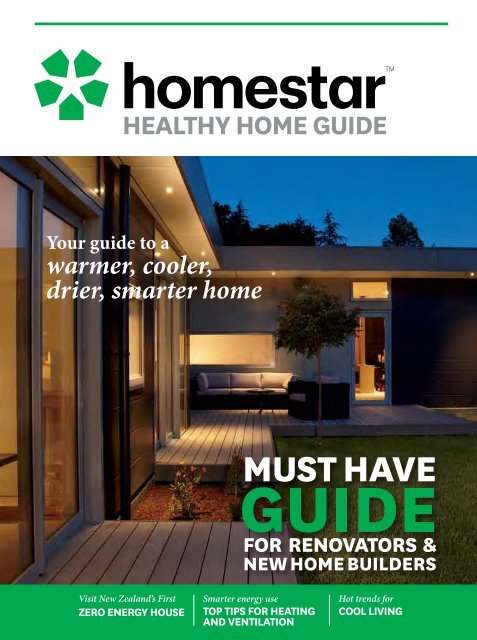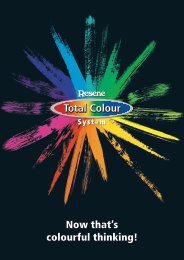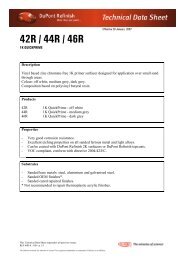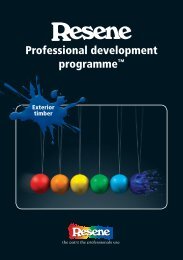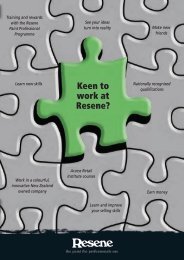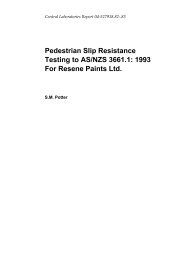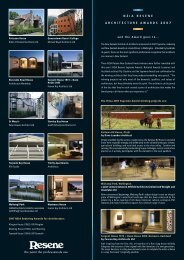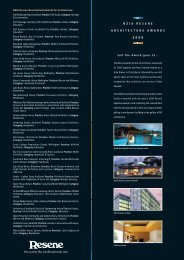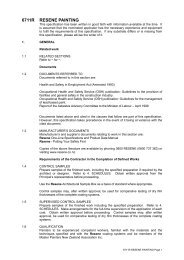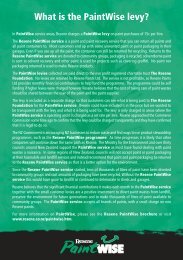Homestar healthy home guide - Resene
Homestar healthy home guide - Resene
Homestar healthy home guide - Resene
You also want an ePaper? Increase the reach of your titles
YUMPU automatically turns print PDFs into web optimized ePapers that Google loves.
HEALTHY HOME GUIDE<br />
Your <strong>guide</strong> to a<br />
warmer, cooler,<br />
drier, smarter <strong>home</strong><br />
Visit New Zealand’s First<br />
ZERO ENERGY HOuse<br />
Smarter energy use<br />
Top tips for heating<br />
and ventilation<br />
Hot trends for<br />
Cool living
You can’t beat the comfort, warmth and<br />
natural beauty of Cavalier Bremworth<br />
wool carpet. Our sustainable New Zealand<br />
wool is naturally stain and fire resistant<br />
and bounces back like no other fibre.<br />
And with environmental accreditation,<br />
it’s a decision you won’t regret, now or<br />
in the future.<br />
Sustainawool n. A natural fibre prized<br />
for its unique ability to keep your house<br />
warmer and drier, its sustainable production<br />
and the fact it keeps our local sheep in jobs.<br />
Browse our full product range and find your<br />
nearest stockist at www.cavbrem.co.nz<br />
2<br />
CAV0249R<br />
HEALTHY HOME GUIDE<br />
New Zealand’s pure wool carpetmaker.
CONTENTS<br />
04 Ensure your <strong>home</strong> performs better<br />
Is your <strong>home</strong> a <strong>healthy</strong> <strong>home</strong>?<br />
06 <strong>Homestar</strong> to the rescue<br />
Why a <strong>healthy</strong> <strong>home</strong> is important<br />
08 New Zealand’s First Zero Energy House<br />
Features to include in your renovation<br />
10 Insulate for health and comfort<br />
Reduce energy waste to reduce bills<br />
13 Lighting the way<br />
Simple ways to reduce energy consumption<br />
14 Homes that measure up<br />
<strong>Homestar</strong> certified houses<br />
18 Sublime sustainability<br />
Architect Paul Clarke<br />
21 The glazing on top<br />
Double glazing<br />
25 Smarter energy use<br />
Top tips for heating and ventilation<br />
29 7 <strong>Homestar</strong> show <strong>home</strong> for Stonewood<br />
A new standard of <strong>healthy</strong>, smarter <strong>home</strong>s<br />
33 Hobson’s Choice<br />
Hobsonville Point gets the <strong>Homestar</strong> tick of approval<br />
Cover image supplied by Hybrid Homes & Living Ltd.<br />
Photographer: Glen Cormier<br />
04 08<br />
14<br />
18<br />
WELCOME<br />
Healthy <strong>home</strong>s are warm, efficient and comfortable.<br />
However, nearly a million Kiwi <strong>home</strong>s are<br />
underperforming when it comes to <strong>home</strong> health, placing<br />
greater stress on our families and costing us more to run.<br />
Here at <strong>Homestar</strong> we’re passionate about improving<br />
the health of Kiwi <strong>home</strong>s, which is why we’ve produced this<br />
booklet. We’ve packed it full of advice and tips for people<br />
renovating, building or simply wanting to improve the health<br />
of their <strong>home</strong>, making it warmer, drier and smarter.<br />
Start your journey by taking the free <strong>Homestar</strong> test<br />
online at www.<strong>home</strong>star.org.nz. This is an independent<br />
service that allows you to gauge how <strong>healthy</strong> and effective<br />
your <strong>home</strong> is. You’ll end up with a rating for your <strong>home</strong>, and<br />
recommendations on how to improve your <strong>home</strong>’s rating.<br />
It’s then over to you to choose what improvements you’ll<br />
make to best suit your needs. On our website you’ll also<br />
find contacts for improvement professionals who have been<br />
trained by <strong>Homestar</strong> to offer unbiased advice and practical<br />
help if you need it.<br />
We’ve included some inspirational best practice examples<br />
such as Auckland’s Zero House on page 8, and international<br />
concepts from Bill Dunster of the ZedFactory - who is a<br />
world expert on sustainable communities and developments,<br />
and who was recently here in New Zealand.<br />
We hope to inspire you and help you take steps to<br />
improve the comfort, efficiency and value of your <strong>home</strong>.<br />
Leigh Featherstone<br />
<strong>Homestar</strong> Director<br />
HEALTHY HOME GUIDE<br />
3
FEATURE<br />
Ensure your <strong>home</strong><br />
performs better<br />
CERTIFIED<br />
ASSESSMENT ONLY<br />
Underperforming New Zealand Standard High Performance Very High Performance Self-sufficient<br />
1 2 3 4 5 6 7 8 9 10<br />
Is your <strong>home</strong> a <strong>healthy</strong> <strong>home</strong>? A <strong>healthy</strong> <strong>home</strong> that’s warm, comfortable,<br />
cost efficient to run and good for the environment too. Everyone benefits.<br />
We’d all like to live in a <strong>home</strong> that<br />
performs well without compromising our<br />
lifestyle. However, many of us don’t know what we<br />
need to do to get our <strong>home</strong> into shape, or how it<br />
stacks up when compared to other New Zealand<br />
<strong>home</strong>s. If you’re a <strong>home</strong>owner, you want to know<br />
that the investment you make on improving your<br />
<strong>home</strong> will not only save on running costs, but could<br />
add capital value in the long run and help safeguard<br />
the environment for future generations.<br />
The free online <strong>Homestar</strong> test, together<br />
with help from a <strong>Homestar</strong> Professional and our<br />
product partners, can <strong>guide</strong> you through design,<br />
construction and maintenance of a healthier, more<br />
naturally comfortable and eco-friendly <strong>home</strong>.<br />
Take a virtual tour of a high rating <strong>Homestar</strong> house<br />
to find out what matters. www.<strong>home</strong>star.org.nz<br />
4<br />
HEALTHY HOME GUIDE
WHERE TO START<br />
3 SIMPLE STEPS WITH HOMESTAR<br />
Step 1: Take the online test<br />
Head to <strong>home</strong>star.org.nz and take our free online test to<br />
rate your <strong>home</strong>’s health. It takes just 20 minutes to complete<br />
the questionnaire, and only requires you to make a few<br />
simple measurements around your house.<br />
Step 2: Action list and plan for improvements<br />
An Action List report can be printed with results<br />
of your <strong>Homestar</strong> rating and can be used for planning<br />
and prioritising your improvements. If you need help<br />
understanding the Action List, simply find a <strong>Homestar</strong><br />
Professional in your area at <strong>home</strong>star.org.nz/services, talk to<br />
your builder or take your list into a builder’s merchant such<br />
as PlaceMakers to help plan what to tackle first. There are<br />
also lots of tips and advice in this <strong>guide</strong> which can provide<br />
immediate and real benefit in terms of quality of living and<br />
running costs of your <strong>home</strong>, such as installing water and<br />
power efficient appliances, extractor fans, LED lighting and<br />
of course insulation.<br />
Step 3: <strong>Homestar</strong> certification<br />
When you have completed your renovation you may<br />
wish to get an independently audited <strong>Homestar</strong> assessment<br />
of the energy and performance improvements you have<br />
made to your <strong>home</strong>. You’ll be given a <strong>Homestar</strong> certificate<br />
which you can use to help promote or sell your <strong>home</strong>.<br />
Though, with all the changes you’ve made, you will probably<br />
want to be there forever!<br />
THE HOMESTAR ICONS<br />
The <strong>Homestar</strong> icons throughout the <strong>guide</strong>, illustrate<br />
what needs to be considered to ensure your <strong>home</strong><br />
performs better.<br />
HEALTH AND COMFORT<br />
Health and comfort assesses how easy it is to<br />
keep the warmth in and the moisture out of<br />
your <strong>home</strong>.<br />
ENERGY<br />
The number and efficiency of appliances and<br />
products in the <strong>home</strong> that use power, plus<br />
any on-site energy generation present.<br />
WATER<br />
The efficiency of taps, showers and toilets<br />
and the need to conserve water, as well as<br />
collecting and re-using rain and greywater.<br />
WASTE<br />
How easy is it to manage and reduce waste in<br />
the house and during construction?<br />
SITE<br />
Where your <strong>home</strong> is located and how to<br />
make the most of passive solar gain.<br />
MANAGEMENT<br />
Guidance on selecting sustainable materials<br />
and keeping track of maintenance on<br />
your <strong>home</strong>.<br />
Find out how you can improve your <strong>home</strong> at <strong>home</strong>star.org.nz twitter.com/<strong>Homestar</strong>NZ facebook.com/<strong>Homestar</strong>NZ<br />
HEALTHY HOME GUIDE<br />
5
TO THE RESCUE<br />
Why a Healthy Home is important<br />
PHOTO: STONEWOOD<br />
Your <strong>home</strong> may look as pretty as a<br />
picture and is the envy of many, but is it<br />
a <strong>healthy</strong> <strong>home</strong>? You may be surprised to<br />
know that nearly a million Kiwi <strong>home</strong>s<br />
underperform in terms of health and<br />
comfort. This is simply not good<br />
enough. It’s affecting our families,<br />
leaving them vulnerable to illness,<br />
and costing us money in terms of<br />
high energy bills and, for some of us,<br />
high water bills.<br />
The good news is there are simple,<br />
practical things <strong>home</strong>owners can do to<br />
improve the health of their <strong>home</strong>.<br />
The first step for <strong>home</strong>owners should be to<br />
complete the free online <strong>Homestar</strong> test, available at<br />
www.<strong>home</strong>star.org.nz, and find out how your <strong>home</strong><br />
could perform better.<br />
Getting it right<br />
Q&A with a <strong>Homestar</strong> Professional<br />
Q | Why is thermal performance important?<br />
To achieve a 3 <strong>Homestar</strong> rating or above, a minimum level<br />
of insulation must be installed in your <strong>home</strong>, so that it is<br />
warmer and healthier. New houses should be built above the<br />
3 <strong>Homestar</strong> standard for a <strong>healthy</strong> <strong>home</strong>, but houses built<br />
before 1978 will require retrofit insulation to be installed to<br />
achieve this.<br />
Q | Why is controlling moisture in the house a top priority?<br />
To achieve a 5 <strong>Homestar</strong> rating or above, as well as having<br />
good insulation, your house needs to have measures to<br />
control moisture. This should include ducted extractor<br />
New Zealand housing has<br />
been widely described as<br />
“old and cold”.<br />
Around 60% of the population<br />
live in <strong>home</strong>s built before<br />
insulation became compulsory<br />
for new dwellings in 1978.<br />
An estimated 84% of dwellings<br />
are estimated to have<br />
inadequate insulation.<br />
fans to remove moisture from bathrooms,<br />
laundries and kitchens.<br />
Q | What about improving water<br />
efficiency in the <strong>home</strong>?<br />
To achieve a 6 <strong>Homestar</strong> rating or<br />
above, your house needs to include<br />
some water efficiency measures<br />
such as installation of dual flush<br />
toilets and showers with a flow rate<br />
of less than 9 litres per minute. In<br />
fact, changing your shower head right<br />
now is one of the easiest and most cost<br />
effective things you can do to save water.<br />
Q | How can I achieve a very high<br />
performance <strong>home</strong>?<br />
To achieve a 7 <strong>Homestar</strong> rating or above, the house must<br />
have additional levels of insulation and thermal mass,<br />
which is more easily achieved in new <strong>home</strong>s or with major<br />
renovations. Examples of how to do this could include<br />
wall cavities thicker than the standard 90 mm, which<br />
allow thicker insulation to be installed, above-code ceiling<br />
insulation and high performance double-glazed windows.<br />
Q | What features does an 8 and above <strong>Homestar</strong><br />
rating require?<br />
To achieve an 8 <strong>Homestar</strong> rating requires more than simply<br />
adding some energy and water savings features. Very high<br />
performance houses reflect international best practice<br />
for sustainable design. They cost less money to run, use<br />
fewer resources to operate and are good for you and the<br />
environment. Find out just how achievable it is by taking a<br />
virtual tour of a high rating <strong>Homestar</strong> house online.<br />
6<br />
HEALTHY HOME GUIDE
HOW HEALTHY IS YOUR HOME?<br />
RATE YOUR HOME TODAY AT www.<strong>home</strong>star.org.nz<br />
When you’re at <strong>home</strong> complete<br />
your <strong>home</strong> health check at<br />
www.<strong>home</strong>star.org.nz<br />
then bring your <strong>Homestar</strong> TM<br />
action list into your local<br />
PlaceMakers and we’ll work<br />
with you to improve your<br />
<strong>Homestar</strong> TM rating.<br />
Founding Gold Partner<br />
One of the easiest ways to<br />
improve your <strong>Homestar</strong> TM rating<br />
is by insulating your <strong>home</strong>.<br />
You can arrange an easy<br />
obligation-free estimate<br />
and see if you qualify for a<br />
$<br />
1,300 Energywise TM Grant<br />
at www.placemakers.co.nz<br />
Delivering on behalf of Tasman Insulation<br />
Know How Card Bonus Vouchers not available with this grant. *A one-off grant of 33% off the costs of retro-fitting insulation, up to a<br />
maximum of $1,300. For full terms and conditions see www.placemakers.co.nz/energywise or contact your local store.
FEATURE CASE STUDY<br />
New Zealand’s first<br />
OPEN<br />
SOURCE<br />
ZERO ENERGY<br />
HOUSE<br />
8<br />
While most of the discussion in Auckland about<br />
housing and real estate seems to centre on hairraising<br />
entry level prices and school zones, there’s a new topic<br />
that’s creating some real waves – energy efficiency. Jo Woods<br />
and Shay Brazier, two young and determined engineers, are<br />
bringing their vision to life of a <strong>home</strong> that’s energy efficient,<br />
while embracing great design and style.<br />
Their new two-storey, three-bedroom <strong>home</strong> will generate<br />
all the energy needed to run the household, though with Jo<br />
and Shay’s philosophy anything that goes into their <strong>home</strong> is<br />
bound to be well-considered and low energy.<br />
To achieve Zero Energy, the design process was wholly<br />
integrated between the architects (A Studio), the engineers<br />
and Shay and Jo. “What’s typical is a sequential process,<br />
where the client briefs the architect, who instructs the<br />
builders and specifiers. In our case we worked together at<br />
every stage of the journey, tweaking the design to be able to<br />
incorporate energy savings to such a great extent,” says Shay.<br />
The house exemplifies a very high performing<br />
sustainable <strong>home</strong>, and is targeting an 8 <strong>Homestar</strong> rating.<br />
This demonstrates that Kiwis can truly live in a warmer,<br />
smarter, drier <strong>home</strong> that has lower running costs over its life.<br />
There are a number of intelligent and sustainable product<br />
and design features that are worth applying to all <strong>home</strong>s.<br />
8<br />
HEALTHY HOME GUIDE
“Over 12 months our<br />
photovoltaic system should<br />
generate as much electricity as<br />
we need and the connection<br />
will mean that should we have<br />
surplus energy we can sell it<br />
back to our electricity provider.<br />
We think that’s a win / win!”<br />
Features of the ZERO ENERGY house to include in your BUILD<br />
Solar orientation<br />
Carefully consider where best to place the house on the<br />
site to maximise solar gain to both the roof and concrete<br />
floor slab (thermal mass). Locate all living areas on the north<br />
side of the house (with kitchen and bathrooms on the south)<br />
to maximise passive solar heating in those places.<br />
The overhang of the first floor can be designed around<br />
seasonal sun angles - in summer (when the sun is higher and<br />
hotter) it provides shading in the downstairs living area, and<br />
in winter (when the sun is lower and colder) it allows sun<br />
into the lower floor, heating the concrete slab.<br />
Thermal insulation<br />
The wall framing design has two layers of installation<br />
oriented at 90° to each other, allowing for an uninterrupted<br />
insulation where the frame passes walls. The Zero Energy<br />
House has 50% more insulation than the standard building<br />
code which will be fundamental in being able to eliminate<br />
the use of heating.<br />
Ventilation<br />
“The cheapest, easiest and most energy efficient<br />
ventilation is passive. Dual-tilt windows (from Heirloom<br />
Joinery) can be left open, even when you are away from<br />
<strong>home</strong> to keep it freshly ventilated.<br />
The tilt system allows the windows to hinge from the<br />
sides and bottom meaning that ventilation occurs at the top<br />
of the window, closer to ceiling height, where it is needed<br />
most, as hot air rises.”<br />
Materials selection<br />
Use recycled timber materials where possible. “We<br />
hunted high and low for all sorts of materials – and it was<br />
worth it. The support beams are from an old catamaran,<br />
while the upstairs flooring is recycled rimu. Our new kitchen<br />
bench is made from old decking timber, and the kitchen<br />
cabinetry will be made from timber recycled from an old<br />
Auckland pub. We’re incorporating a bit of history into our<br />
brand-new <strong>home</strong>,” says Jo. The couple have also used non-<br />
PVC pipework to reduce toxicity onsite as well as on-treated<br />
macrocarpa cladding which minimises contaminants on site.<br />
Solar energy<br />
Solar systems contribute 70% of the Zero Energy goal.<br />
The other 30% is down to the building envelope design<br />
which eliminates space heating needs. The solar hot water<br />
system (Artline, from SolarCity) is New Zealand-made<br />
and has been manufactured in Christchurch for 30 years.<br />
It provides almost all of the water heating needs in the<br />
house. Solar is becoming a more economic choice for Kiwis<br />
contemplating new builds and renovations,” says Shay.<br />
The solar photovoltaic system used on the Zero Energy<br />
House is New Zealand’s first integrated PV roofing tile. It<br />
replaces the roof and is fixed to roof battens like normal<br />
roofing tiles. 88 of them are laid out to cover most of the<br />
north-facing roof.<br />
“Over 12 months our PV system will generate at least<br />
as much electricity as we consume and the connection will<br />
mean that should we have surplus energy, we can sell it back<br />
to our electricity provider. We think that’s a win / win!” says Jo.<br />
HEALTHY HOME GUIDE<br />
9
Insulate for health<br />
and comfort<br />
Insulation is essential to keep your <strong>home</strong> warm in winter and cool in summer.<br />
PHOTO: STONEWOOD<br />
well-insulated <strong>home</strong> will provide year-round<br />
A comfort, and cost less to cool and heat. Insulation also<br />
helps to reduce noise levels and condensation. Research has<br />
found that installing insulation will lead to health benefits<br />
such as reduced incidence of asthma.<br />
While there are minimum requirements for insulation in<br />
new <strong>home</strong>s and additions, it’s worth spending a little more<br />
to exceed these requirements and get an even warmer, more<br />
comfortable <strong>home</strong> with lower power bills. A <strong>Homestar</strong><br />
consultant, your builder or architect should be able to tell<br />
you how much insulation you will need.<br />
There are many insulation materials available including<br />
wool, polystyrene, glass wool, mineral wool and paper<br />
based insulation.<br />
Most heat is lost through the ceiling and roof, so that<br />
should be your top priority. About 42% of heat loss from an<br />
average uninsulated <strong>home</strong> occurs through this area (up to 60%<br />
in older houses).Up to 20% of heat loss occurs through the<br />
floor of uninsulated houses. Insulation can easily be retrofitted<br />
on the underside of suspended timber or concrete floors as<br />
well as on the edge and underside of concrete floor slabs.<br />
About 24% of heat, from an average uninsulated <strong>home</strong>, is<br />
lost through the walls. If you’re using a framed construction<br />
system, insulation should be placed within the wall framing.<br />
If you’re building from scratch consider increasing the<br />
framing size to fit in more insulation. (See how the Zero<br />
Energy House, Pages 8 and 9 has done this.)<br />
Proper installation is critical for making sure insulation<br />
works effectively and is safe. While it’s essential to avoid<br />
creating gaps and spaces, as they will allow warm air to<br />
bypass the insulation and escape, in some spaces (such as<br />
around many types of downlight fittings and chimney flues) a<br />
safety gap is required. You can install some kinds of insulation<br />
yourself, such as blanket insulation, but it is recommended<br />
you get a professional if you require a lot of safety clearance<br />
gaps (for example, where you have a lot of downlights).<br />
10<br />
HEALTHY HOME GUIDE
1<br />
Seam Cushions made from up-cycled pure NZ<br />
Wool blankets, sewn in Wellington, New Zealand<br />
by Sue McMillan. www.ikoiko.co.nz<br />
Diver $79 | Elephant $79<br />
2<br />
Ledino Luminaires<br />
Suspension Light<br />
With 3x 7.5W integrated LEDs,<br />
and in stylish aluminium finish.<br />
RRP | $499.95 inc GST<br />
Hot trends<br />
Cool<br />
for<br />
living<br />
Hungry Bins | Buy a hungry bin with worms and<br />
save! A hungry bin and 500 grams of live worms is<br />
all you need to start composting today.<br />
www.hungrybin.co.nz<br />
Hungry bin and 500g live worms<br />
RRP | $325 plus freight<br />
3<br />
4Ecostore<br />
Laundry Powder<br />
1kg RRP | $8.89<br />
This plant and mineral based<br />
laundry powder is also<br />
economically concentrated which<br />
means a little really goes a long<br />
way, saving you money by cutting<br />
down significantly on cost per use.<br />
Electrolux 510 L French Door Fridge<br />
Best in class energy efficiency, this fridge has an eco<br />
mode to reduce your energy use plus Eco/vacation<br />
5<br />
energy efficient mode and uses a non-synthetic<br />
refrigerant, with a lower global warming<br />
potential than conventional refrigerants<br />
used in most fridges. RRP | NZ $3,599.95<br />
6<br />
Miranda Brown ‘Free The Sea’<br />
Female Baggy T-shirt<br />
This T-shirt is made of organic<br />
cotton and dyed with vegetable<br />
dyes and print ink. $5 will go<br />
to your chosen organisation.<br />
www.mirandabrown.co.nz<br />
RRP | $65.00 (Kids range from<br />
$44 – 49, Adults $55 – $69)<br />
HEALTHY HOME GUIDE<br />
11
Giving light a<br />
new experience<br />
Philips Ledino – energy efficient lighting that<br />
brings a natural sense of beauty into your <strong>home</strong><br />
With stylish designs and integrated LED light sources, the<br />
Philips Ledino range is perfect for the sophisticated <strong>home</strong>.<br />
The natural white light creates the atmosphere you want,<br />
thanks to state-of-the-art power LEDs. Together, they’ll give<br />
your <strong>home</strong> interior a beautiful diffused white accent.<br />
And with an energy-efficient light source that lasts up<br />
to 20 years, you’ll never change a light bulb again.<br />
See what light can do<br />
Available from
Lighting the way<br />
Lighting represents an area for considerable energy<br />
savings for many households. New technologies are<br />
emerging all the time and the<br />
latest to hit our shores is LED<br />
(Light Emitting Diode) lighting.<br />
Philips, a world-leader in<br />
this area has recently launched<br />
the myVision and myAmbiance<br />
bulbs designed to give<br />
<strong>home</strong>owners even more choice<br />
and at a lower price point. And<br />
why wouldn’t you make the switch? The new LED bulbs use<br />
up to 80% less energy than incandescent bulbs and can last<br />
15-25 times longer! With lighting making up around 12% of<br />
the average New Zealand <strong>home</strong>’s electricity bill, converting<br />
to energy efficient lighting is one simple and effective way to<br />
reduce overall energy consumption.<br />
One of the concerns many Kiwis have is whether energy<br />
efficient bulbs will work with their lights’ dimmer switches.<br />
Fortunately incompatibility with dimmers is not an issue<br />
with LED. The Philips myAmbiance LED Bulb is dimmable<br />
and, what’s more, uses only 12W of power to generate more<br />
light than a standard 60W bulb. Designed to resemble a<br />
traditional frosted light bulb, the LEDs fit into existing screw<br />
or bayonet cap sockets, enabling an easy transition to LED<br />
lighting. All Philips LEDs are mercury-free and produce high<br />
quality natural shades of white light.<br />
Incandescent bulbs have a typical life of<br />
1,000 hours, and compact fluorescents about<br />
6,000 to 8,000 hours. LED bulbs maintain<br />
output light intensity well over their lifetimes.<br />
They are also mercury-free, unlike<br />
fluorescent lamps. LED lamps are available<br />
with a variety of colour properties.<br />
There’s no denying that LED lightbulbs are more<br />
expensive than their incandescent equivalents, however this<br />
is more than made up for in terms<br />
of savings in energy consumed and<br />
replacement costs over the average<br />
15-25 year life of a LED bulb. In<br />
fact, EnergyWise goes so far to<br />
say that if every household in New<br />
Zealand used efficient lighting,<br />
this would save the same amount<br />
of power that Hamilton uses each<br />
year. See ecca.energywise.govt.nz for more information.<br />
Philips LED bulbs are available nationwide with pricing<br />
starting at $19.99 including GST.<br />
LED energy-SAVERS<br />
• Up to 80% energy saving over<br />
equivalent incandescent light bulbs<br />
• Very long lifetime of up to 15,000<br />
hours or 20 years<br />
• Minimal ongoing lamp<br />
replacement costs<br />
• Cool beam of light<br />
• Instant start<br />
• Comfortable, glare-free lighting<br />
HEALTHY HOME GUIDE<br />
13
FEATURE<br />
Certified houses<br />
Homes that measured up<br />
The “Rakaia” CUBE<br />
Falcon Construction<br />
HIVE Housing Innovation Park, Canterbury<br />
www.prefabnz.com/Hive/Falcon-Construction/<br />
The cube is born! The 4 <strong>Homestar</strong> rated CUBE is a<br />
precast concrete system that is earthquake engineered.<br />
The basis of the CUBE is an 8 x 4m structure that is<br />
connected together to other pods vertically or horizontally<br />
with no limits on what the end product can become. It is<br />
engineered to construct anything from single to multilevel<br />
structures, commercial or residential. Not only does it have<br />
great engineering qualities but it is designed to provide a safe<br />
warm and low-maintenance environment.<br />
This revolutionary system has the ability to be<br />
constructed 4-5 times faster than a traditional build and<br />
deconstructed and relocated if required. The first 3-bedroom<br />
<strong>home</strong> was completed in 14 days, which is beneficial,<br />
especially to meet the demands of the Canterbury rebuild.<br />
Another key to the CUBE is its ability to be used as either<br />
a permanent or temporary structure. The modular structure<br />
can be deconstructed and moved to another site to either<br />
replicate the original building or to create an entirely new<br />
building design. Much like a giant Lego set!<br />
14<br />
HEALTHY HOME GUIDE
Broad oaks<br />
Private Home<br />
Designed by<br />
Russell devlin<br />
John and Margaret Hayman, Huntsbury, Christchurch<br />
The 6 <strong>Homestar</strong> rated <strong>home</strong> designed by Christchurch based solar architect<br />
Russell Devlin has:<br />
> Four bedrooms spread over<br />
two levels<br />
> A total floor area of 240 square<br />
metres, including a spacious double<br />
garage with internal entry<br />
> Inclusive design with wide<br />
entrances and an internal structural<br />
wall that can accommodate a chair<br />
lift in the future if required<br />
> A clever use of tiles for thermal<br />
mass adjacent to floor-to-ceiling<br />
windows on the sunny aspects<br />
> Specifically chosen light fittings<br />
allowing a full layer of insulation<br />
to be laid safely across the ceiling<br />
> A central, structural block wall<br />
to increase thermal mass within<br />
the <strong>home</strong><br />
> Easy care maintenance with a<br />
comfortable range of temperature<br />
and humidity<br />
> Half the average energy<br />
consumption of a<br />
New Zealand <strong>home</strong><br />
HEALTHY HOME GUIDE<br />
15
FEATURE<br />
Certified houses<br />
Homes that measured up<br />
Young way<br />
You can see why this beautiful Hybrid Home, which<br />
targeted a 6 <strong>Homestar</strong> rating, was recently awarded<br />
the winner of the prestigious Registered Master Builders<br />
Category within the Nelson district Sustainable Homes<br />
$500K-$1m category.<br />
Their brief was to deliver an efficient, modern <strong>home</strong> with<br />
all the mod-cons and unique design features. The owners<br />
are delighted with the result, as their <strong>home</strong> boasts stunning<br />
design, use of space, comfort and is so efficient that they can<br />
retire with peace of mind about running costs.<br />
.<br />
Design and efficiency features include:<br />
> Passive solar design to capture natural heat from the sun<br />
> Ultra efficient building systems<br />
> Solar grid connect system and solar hot water<br />
> Rain water collection<br />
> Grey water recycling<br />
> Water and energy efficient appliances<br />
> Locally sourced products (where possible)<br />
> Non-treated Douglas fir framing (where possible)<br />
> Used non-toxic glues and resins<br />
> Used low VOC paints and finishes<br />
> Natural wool carpets<br />
> New Zealand and Australasian fit-out materials such as<br />
Caroma and Methven<br />
The house is designed with a series of electric windows to<br />
allow for air circulation and a sensor operated skylight in the<br />
central hallway which acts as a natural ventilator.<br />
16<br />
HEALTHY HOME GUIDE
Leave a lighter environmental footprint<br />
with the only New Zealand made insulation<br />
containing over 80% recycled glass<br />
Abel Tasman National Park<br />
For the last decade we have been manufacturing our product from up to 80% recycled glass, but from the<br />
beginning of 2012 our Auckland plant became one of the first in the world to consistently make insulation<br />
using 83% recycled glass content. Our Christchurch plant will soon follow, recycling excess broken glass<br />
from some of the city’s iconic buildings, that might otherwise go to landfill.<br />
A piece of New Zealand<br />
Visit our website to learn more about<br />
Pink ® Batts ® Insulation and Sustainability.<br />
www.pinkbatts.co.nz
FEATURE<br />
Sublime<br />
Sustainability<br />
This exquisite holiday <strong>home</strong> is<br />
‘sustainability’ personified. The<br />
clients worked with their architect<br />
and local tradespeople and builders<br />
to create a <strong>home</strong> that truly celebrates<br />
the space it occupies and protects the<br />
spirit of Great Barrier.<br />
Although architect Paul Clarke<br />
had pretty much free rein to come<br />
up with a suitable design, the owners,<br />
Kim and Frances, had a firm<br />
notion that the house was to be<br />
environmentally sensitive.<br />
“This place, indeed all of Great Barrier<br />
Island, is a very special place. We<br />
wanted to ensure what we did helps<br />
keep it that way.”<br />
The house rates very highly on<br />
some key <strong>Homestar</strong> points including<br />
orientation to the sun, use of natural<br />
and sustainable recycled materials,<br />
energy efficiency and waste and site<br />
management. “The house, with the help<br />
of sun and rain, hums along in a perfect<br />
synergy with no assistance from the<br />
outside world,” says Paul Clarke.
FEATURE<br />
Focus on sustainability<br />
The exposed and oiled cedar was supplied by Herman<br />
Pacific based in Silverdale and met FSC (Forest Stewardship<br />
Council) certification. The external open deck and internal<br />
floors were made from sustainable Vitex timber from the<br />
Solomon Islands. In July 2007 a major storm hit Auckland<br />
and Northland. Great Barrier Island was hard hit: thirteen<br />
blackwood trees were blown over. The resulting timber has<br />
been incorporated in the house in furniture and fixings.<br />
A major feature of the house is the exterior fixed<br />
windows and sliding doors. The glass used consists of two<br />
5mm glass sheets laminated together with 0.38mm of PVB<br />
laminate making it a safety glass manufactured with a<br />
permanent transparent coating which is glazed to the inside<br />
of the house.<br />
The owners chose <strong>Resene</strong> Zylone Sheen VOC free<br />
painted tinted to Alabaster which is an Environmental<br />
Choice approved product.<br />
As Great Barrier Island has no mains power or water<br />
supply, alternatives have to be found by residents. Water is<br />
heated through two roof mounted solar panels and stored in<br />
a large heavily insulated cylinder, reaching as much as 82C.<br />
“The house, with the help<br />
of sun and rain, hums<br />
along in a perfect synergy<br />
with no assistance from<br />
the outside world,”<br />
Paul Clarke<br />
The electrical system comprises some 1050Kw of<br />
photovoltaic cells. All electrical appliances meet the criteria<br />
for low energy consumption. The Jetmaster fireplace is<br />
fuelled by trees which have been blown over or pruned. The<br />
house is lined with wool-based and other building code<br />
mandated insulation.<br />
LED lighting is used extensively throughout the house –<br />
it’s effective and keeps power consumption to a minimum.<br />
All water used in the house comes from rainwater with<br />
filtration mechanisms including a UV sterilisation system<br />
for drinking water. The septic tank system filters effluent<br />
through a sand filter and pumps the highly purified liquid<br />
into pipelines in the regenerating bush to the north of the<br />
house. Plants and trees are irrigated using an automated<br />
irrigation system supplied by water pumped from the<br />
adjacent stream into a holding tank on the hill.<br />
Any advice from Kim and Frances for others thinking<br />
of employing the same sustainability principles? “Oh yes, we<br />
think as owners you need to spend time to learn as much as<br />
you can about the options available and compromise only<br />
when there is no practical alternative.”<br />
19<br />
HEALTHY HOME GUIDE
Before you renovate your place, visit our place<br />
Visit our website to find out about all the things you can do to use less energy every day. Find<br />
out how to make your <strong>home</strong> warmer and healthier, get some energy efficiency renovating tips,<br />
make smart lighting and appliances choices, get lower power and fuel bills and more. It’s all at<br />
www.energywise.govt.nz<br />
www.energywise.govt.nz
The glazing on top<br />
Double Glazing<br />
Better window insulation will add comfort and energy<br />
efficiency to your <strong>home</strong> all year round. You’ll enjoy the<br />
benefits of less noise, a warmer house in winter and cooler<br />
house in summer, reduced energy bills and a healthier <strong>home</strong>.<br />
What is double glazing?<br />
Double glazing is made from two or three glass window<br />
panels sealed together with an air filled space. Double<br />
glazed windows will help keep generated heat inside,<br />
keeping your <strong>home</strong> at a more consistent temperature -<br />
cutting down your power costs. They also help to reduce<br />
sound transfer and condensation.<br />
Benefits of double glazing<br />
> Warmer in winter<br />
> Cooler in summer<br />
> Reduces condensation<br />
> Reduces energy usage<br />
> Reduces noise<br />
> Enhances resale value<br />
Maximise thermal insulation of your double glazing<br />
The air filled space between glass panels can be replaced<br />
with argon gas, a naturally occurring non harmful gas, to<br />
increase the insulation performance by up to 15%. Using a<br />
combination of argon gas and low-E, or low emissivity glass,<br />
you will receive ultimate insulation performance.<br />
Although single-glazed low-E glass can offer some<br />
increase in thermal performance, the following should<br />
be noted:<br />
> Low-E glass is extremely hard to clean and can show<br />
finger marks<br />
> Low-E glass is a coated glass and the coating can be<br />
scratched or damaged<br />
> Low-E glass is normally more expensive than a standard<br />
Double Glazed window<br />
> Low-E glass has less thermal performance than standard<br />
Double Glazing<br />
> Low-E glasses have different R values, and some types may<br />
not meet the 0.26 requirement of the new Energy Standard<br />
There are of course circumstances when single-glaze<br />
low-E glass is suitable, however you need to carefully<br />
consider why you would use this over double glazing. When<br />
used as one skin of a double glazed window the benefits are<br />
real, without the hassle of these issues.<br />
Do you have an older <strong>home</strong> and don’t have the<br />
budget for double glazing?<br />
Metro-Fit double glazing is the process of replacing<br />
your existing single glazing with insulating glass units. The<br />
process is quick and unobtrusive. Thermal backed curtains<br />
will also help to reduce heat loss. The only difference you will<br />
notice is a more comfortable temperature all year round.<br />
Home safety checklist<br />
Your <strong>home</strong> should also be a safe and secure place for you<br />
and your family, follow these quick steps to ensure your<br />
<strong>home</strong> is as safe as you want it to be.<br />
Check off the following<br />
safety features<br />
> A well–defined main entrance showing<br />
house name / number clearly visible from<br />
the road<br />
> A clear view from the house to the street or road frontage<br />
(e.g. fences of less than 1.2 metres in height that allow<br />
people inside the house to view the street)<br />
> Outdoor security lighting fitted with motion and<br />
daylight sensors<br />
> Secure locks and catches on all ground floor doors<br />
and windows<br />
> Laminated or toughened safety glass on all windows<br />
and glass doors that are below 1m in height<br />
> A fire extinguisher in an easily accessible place in the<br />
kitchen (tested and in date)<br />
> Working smoke alarms within 3m of all sleeping areas<br />
or a domestic sprinkler system<br />
> Secure child resistant storage for hazardous substances<br />
and medicines (cupboards above 1.5m in height and/or<br />
fitted with child resistant locks)<br />
HEALTHY HOME GUIDE<br />
21
MATERIALS MATTER<br />
PrOTECT your family health and the environment by choosing building<br />
and interior furnishing materials carefully.<br />
The best materials for your building and <strong>home</strong> interior will be:<br />
> non-toxic<br />
> durable and strong<br />
> make your <strong>home</strong> more comfortable and efficient<br />
> sourced sustainably, independently certified,<br />
reusable and/or recyclable<br />
Materials used in <strong>home</strong> construction and <strong>home</strong> interiors<br />
can contain chemicals that may be harmful to human<br />
health as well as the environment, such as solvents and<br />
volatile organic compounds (VOCs). VOCs are chemicals<br />
that become airborne (and therefore breathable) at room<br />
temperature. They are present in many household cleaners<br />
and hairsprays, carpets and textiles, engineered timbers such<br />
as medium density fibreboard (MDF), glues, paints and many<br />
other materials used in our <strong>home</strong>s. VOCs have been linked<br />
to health problems, including asthma and skin conditions.<br />
Some chemicals that give off VOCs - for example, benzene,<br />
which is used in polyurethane - can be carcinogenic. Some<br />
timber treatments use toxic chemicals such as chromium<br />
and arsenic that may leach out when exposed to weather.<br />
Materials may have longer or shorter durability depending<br />
on maintenance. For example, timber weatherboards require<br />
painting - provided this is done, they have good durability.<br />
Choose products that have eco-labels or environmental<br />
certification schemes to show that they have been produced<br />
in a sustainable way and are not harmful to health. Look for<br />
eco-labels and certification that are independent and have<br />
government backing, such as Environmental Choice New<br />
Zealand. For more information on eco-labelling schemes in<br />
New Zealand, see rating and labelling schemes.<br />
Focusing on paint<br />
with <strong>Resene</strong><br />
Since <strong>Resene</strong> launched the first<br />
waterborne paint in New Zealand in<br />
the 1950s, they have always been keenly<br />
aware of the need to reduce the risk<br />
products may present to customers and<br />
the environment. <strong>Resene</strong> joined the<br />
Environmental Choice programme in<br />
1996 and now has an extensive range<br />
of waterborne low VOC paints and<br />
VOC free paint and tinters<br />
suitable for decorating projects inside and<br />
out. By choosing a waterborne paint rather<br />
than solvent borne paint for your project<br />
you can significantly reduce the VOCs<br />
emitted and enjoy the lower odour and<br />
easy wash up in water.<br />
Why is glass wool the most popular insulation material<br />
in New Zealand and the world?<br />
Insulation products made of glass wool possess a number of characteristics that<br />
natural fibre and polymer based products do not have.<br />
> Glass wool is manufactured mainly from recycled glass, originally derived from<br />
abundant natural minerals such as sand. Products such as polyester and polystyrene<br />
are made from chemical derivatives of oil industry products<br />
> Mineral wools such as glass wool are non-combustible, meaning they won’t catch fire<br />
even when continuously exposed to a flame<br />
> Reputable glass wool insulation is also bio-soluble and has been independently<br />
researched over the last 50 years to be safe for use as insulation.<br />
22<br />
HEALTHY HOME GUIDE
Keep your place<br />
with a <strong>Resene</strong> CoolColour TM<br />
Freshen up your next paint job with <strong>Resene</strong> Zylone<br />
Sheen VOC Free, which combines the popular<br />
low sheen of <strong>Resene</strong> Zylone Sheen without the<br />
unwanted volatile organic compounds (VOCs) for<br />
better indoor air quality.<br />
Improved air quality can help prevent headaches,<br />
asthma, nausea, respiratory complaints and allergic<br />
reactions. And to suit all tastes, <strong>Resene</strong> Zylone Sheen<br />
VOC Free is available in a wide range of popular<br />
<strong>Resene</strong> colours using <strong>Resene</strong> non VOC tinters.<br />
Now that’s fresh thinking.<br />
Ever thought a house or building would look<br />
great painted in a sleek, dark colour – then had<br />
to shelve plans for fear of the heat damaging the<br />
substrate or the building getting unbearably hot<br />
in summer?<br />
Well, forget all that. <strong>Resene</strong> CoolColour TM<br />
technology makes painting exterior surfaces in<br />
dark colours both easier and safer. It can be used<br />
on all sorts of exterior materials and applications,<br />
from weatherboards and concrete to windowsills.<br />
A <strong>Resene</strong> CoolColour is designed to reflect more of<br />
the sun’s energy than a standard colour reducing<br />
stress on the coating, substrate and building<br />
keeping them cooler.<br />
Get inspired with a<br />
<strong>Resene</strong> The Range<br />
fashion colours fandeck<br />
worth $9.95 FREE!<br />
Simply bring this ad into your local <strong>Resene</strong> ColorShop and we’ll<br />
give you the latest <strong>Resene</strong> The Range fashion colours fandeck<br />
brimming with colours designed for 2013 and beyond.<br />
Limited to one The Range fashion colours fandeck per advertisement at <strong>Resene</strong>-owned<br />
ColorShops only until 30 May 2013 or while stocks last.<br />
0800 RESENE (737 363) www.resene.co.nz<br />
HEALTHY HOME GUIDE<br />
23
Wrap yourself<br />
In nature<br />
Health & Comfort<br />
It’s all very well heating the <strong>home</strong>, but unless<br />
you have proper insulation and ways of trapping<br />
heat, it’s a highly ineffective and costly exercise. Look to<br />
partner good insulation and heating with materials that<br />
are effective, safe and sustainable.<br />
Where do I start?<br />
We’re lucky in New Zealand, as we can simply<br />
choose products that carry the Environmental Choice<br />
New Zealand mark. The mark means that products<br />
meet best environmental practice standards in terms<br />
of materials used, energy consumed, water conserved,<br />
waste produced and discharged, and emissions.<br />
Consider health implications when choosing<br />
linings, pipework, paint, carpet, glue and sealants that<br />
make up and decorate your <strong>home</strong>. Many materials give<br />
off pollutants over time that can affect the health of you<br />
and your family. Choose materials that use less energy<br />
to produce or are made from renewable sources.<br />
Wool carpets and rugs act as a natural humidity<br />
regulator – keeping your house warmer in winter<br />
and cooler in summer and they reduce moisture,<br />
which in turn minimises condensation and mold.<br />
With New Zealand’s expertise raising sheep we have<br />
an abundance of wool, making woolen carpets and<br />
rugs the sustainable choice.<br />
Wool is fully biodegradable and can be recycled.<br />
Recently Cavalier Bremworth introduced a world-first<br />
with its new Flashbac carpet backing made entirely<br />
from recycled wool carpet. This is being introduced to<br />
all Cavalier Bremworth carpet ranges and is expected to<br />
divert more than 120 tonnes of waste carpet away from<br />
landfill each month.<br />
Partner insulation and heating with effective, safe and sustainable materials<br />
by choosing products that carry the Environmental Choice New Zealand mark.<br />
24<br />
HEALTHY HOME GUIDE
Smarter Energy Use<br />
in Your Home<br />
Streamlining your energy use means savings for you and less impact<br />
on the environment. Take some simple steps to cut your energy waste,<br />
making your <strong>home</strong> healthier, smarter and more comfortable.<br />
ECCA approved Energy saving tips<br />
WATER HEATING<br />
Water heating typically accounts for<br />
a third of your electricity bill, and is<br />
the largest energy expense in your<br />
<strong>home</strong>. Cutting out hot water waste<br />
will lower your energy bills and your<br />
carbon footprint.<br />
There are three ways to cut your<br />
water heating bills:<br />
> Use less hot water. Use cold water for<br />
washing your clothes as this uses 75%<br />
less electricity than hot water washes<br />
and, at four loads a week, could save<br />
you around $50 to $75 each year<br />
> Set your water heater’s thermostat<br />
correctly. It should not be more than<br />
55° Celsius at the tap and 60° Celsius<br />
at the cylinder to prevent the growth<br />
of Legionella bacteria<br />
> If you have an electric hot water<br />
cylinder, insulate it. Wrap your<br />
cylinder and hot water pipes with<br />
special insulation wraps available at<br />
your hardware store<br />
HOUSE HEATING<br />
> Installing or upgrading your <strong>home</strong>’s<br />
insulation is one of the most effective<br />
ways to have a warm <strong>home</strong>, reduce<br />
your energy waste and therefore<br />
reduce your bills<br />
> An envelope of insulating materials in<br />
ceilings, floor and walls keeps a house<br />
warm during winter and cool during<br />
summer, and helps control moisture<br />
> You may also be entitled to the<br />
government’s Warm Up New Zealand:<br />
Heat Smart insulation subsidy to<br />
help with the cost. Check it out<br />
on the ENERGYWISE website:<br />
www.energywise.govt.nz/fundingavailable/insulation-and-clean-heating<br />
> Heat loss through windows can<br />
account for 10% to 25% of your<br />
heating bill. If your <strong>home</strong> has<br />
singlepane windows, as many<br />
New Zealand <strong>home</strong>s do, consider<br />
replacing them with new doubleglazed<br />
windows. At the very least,<br />
make sure you hang them with thick,<br />
thermal-lined curtains, and draw<br />
these as soon as the sun goes down<br />
> There are lots of energy efficient,<br />
clean heating devices available these<br />
days, including modern wood and<br />
wood-pellet burners, ENERGY STAR<br />
qualified heat pumps, and high starrated,<br />
flued gas heaters<br />
APPLIANCES & REFRIGERATION<br />
> When it comes time to replace your<br />
old appliances, use the ENERGY STAR<br />
and the energy rating label to help<br />
you choose the most energy efficient<br />
new model to suit your needs<br />
> Appliances like fridges use a lot of<br />
energy, are on all of the time and<br />
tend to be held on to for a long time.<br />
The average New Zealand fridge is<br />
16 years old and costs $200 a year<br />
more to run than a modern, energy<br />
efficient model. If you want to know<br />
at a glance which are the most energy<br />
efficient, follow the ENERGY STAR<br />
system. The blue ENERGY STAR<br />
mark is awarded to products that<br />
are amongst the 25% most energy<br />
efficient in their category<br />
> If you want to compare the annual<br />
energy use of one product to another,<br />
similar product, use the energy rating<br />
label. The red and white stars on the<br />
energy rating label shows at a glance<br />
how energy efficient a product is, and<br />
the average expected annual energy<br />
use of an appliance over a year is<br />
given in kilowatt hours per year<br />
> Use the sun to dry your clothes<br />
rather than a dryer as much as<br />
possible. This could save you around<br />
$200 each year<br />
COOKING<br />
> Make sure you have good extraction<br />
systems in the wet areas in the <strong>home</strong><br />
(bathroom, laundry and kitchen).<br />
Fans or extractors need to vent<br />
to outside your house, not just<br />
recirculate damp air inside your<br />
ceiling space<br />
> Extractor fans need to be sized<br />
and located properly to cooking<br />
equipment such as stove tops<br />
LIGHTING<br />
> Making improvements to your<br />
lighting is one of the fastest ways to<br />
cut your energy bills. An average<br />
household dedicates 12% of its energy<br />
budget to lighting. Using new lighting<br />
technologies can reduce lighting<br />
energy use in your <strong>home</strong> by 50%<br />
to 75%<br />
> Turn lights off when a room is empty<br />
> Use natural light as much as possible<br />
> All outdoor lighting should be fitted<br />
with integrated daylight and motion<br />
sensing controls<br />
(See tips in Lighting the Way)<br />
HEALTHY HOME GUIDE<br />
25
Go Green & GrOW<br />
Renovate using ‘green’ concepts and increase the value of your <strong>home</strong><br />
Whether you’re looking at building a new <strong>home</strong>,<br />
a wholesale <strong>home</strong> makeover or just a tidy up, it<br />
certainly pays to look into ways to make your <strong>home</strong> both<br />
look and work better. You’ll certainly benefit in the long run.<br />
Orientation to the sun and good insulation were selected<br />
as the two top priorities for house hunters according to<br />
a recent study released by realestate.co.nz, more so than<br />
a fabulous granite kitchen bench! Consider factors that<br />
improve your passive (no cost) warmth by room positioning<br />
and cost effective heating solutions.<br />
Remember the free online <strong>Homestar</strong> tool is available,<br />
or pay a <strong>Homestar</strong> Professional to give you clever ideas for<br />
saving energy, creating warmer and healthier surroundings<br />
and smart ways to save water and reduce waste.<br />
<strong>Homestar</strong> top 10 things to consider when building or renovating<br />
01 Insulate<br />
Top of the list is to invest in insulation; Ceiling insulation,<br />
exterior and interior walls and under floor. Initiatives like Warm<br />
Up New Zealand provide subsidised <strong>home</strong> insulation meaning<br />
warmer <strong>home</strong>s are now more affordable.<br />
02 Plug the gaps<br />
Many of our older wooden <strong>home</strong>s tend to have lots of little<br />
gaps. These gaps, which can be found under doors and around<br />
old window frames, can all add up to be a sizable hole – letting<br />
warmth out and chilly air in.<br />
03 Warm things up a little<br />
Choosing effective heating options such as energy efficient heat<br />
pumps, modern wood burners and externally-flued gas heaters<br />
can make a big difference to the power bill.<br />
04 Invest in efficient appliances<br />
Choose products that have the blue Energy Star mark including<br />
white ware, <strong>home</strong> electronics, heat pumps, and lighting. The<br />
Energy Star is only awarded to the top 25% most energy efficient<br />
appliances in a category. Old fridges and freezers can be a silent<br />
but significant load on power consumption.<br />
07 Free ways to save<br />
Washing your clothes in cold water and drying clothes outside<br />
are simple and free ways to save both electricity and money.<br />
08 WATch the water<br />
For most New Zealand <strong>home</strong>s heating water is the biggest energy<br />
expense. Reduce water heating costs by checking that the water<br />
temperature is no more than 55°C.<br />
09 Beauty is more than skin deep<br />
Consider using materials that will absorb and store the sun’s<br />
warmth effectively. A <strong>home</strong>’s exterior that is made of heavy<br />
and dense materials such as concrete, stone and brick will<br />
do this best. Including heat-absorbing materials in building<br />
and renovation plans can really make a difference on a <strong>home</strong>’s<br />
heating costs.<br />
10 Waste not, want not<br />
When planning your garden consider planting your own<br />
vegetable and herb garden and employing composting<br />
techniques. It’s so rewarding to see how using waste matter<br />
better, results in healthier, flourishing gardens.<br />
05 Rethink your lighting<br />
Compact fluorescent light bulbs (CFL) use less power and last<br />
longer than regular incandescent bulbs. Replacing twenty bulbs<br />
could save the average <strong>home</strong>owner around $300 in the first year<br />
alone. New to the market is LED lighting – even more efficient<br />
than compact CFLs.<br />
06 Go for comfort<br />
Including carpeting in a renovation is a way to instantly change<br />
the look and feel of a <strong>home</strong>, and to add immeasurably to comfort.<br />
There are so many great natural and allergen-free choices on<br />
the market today. Not only does carpet transform a room, it also<br />
provides yet another layer of insulation.<br />
26<br />
HEALTHY HOME GUIDE
BRANZ, New Zealand’s leading research, testing, consulting and building<br />
knowledge company have just launched their new “Renovate” website.<br />
This website complements the existing<br />
Renovate Series of publications detailing<br />
everything you need to renovate <strong>home</strong>s<br />
from different eras.<br />
Offering tools to assist planning,<br />
regulation and compliance requirements<br />
with crystal clear drawings highlighting<br />
typical construction methods.<br />
www.renovate.org.nz<br />
HEALTHY HOME GUIDE<br />
27
CASE STUDY<br />
Warmer, Drier,<br />
Smarter<br />
Incorporating eco-friendly and sustainable design ideas into renovation<br />
earned this house a 7 <strong>Homestar</strong> rating.<br />
7<br />
Photo courtesy of <strong>Resene</strong> habitat<br />
When Edie and Hillary van Uden chose to renovate<br />
their ex-state 1950’s <strong>home</strong> in Auckland in 2009, they<br />
challenged themselves to make it as sustainable and energy<br />
efficient as possible.<br />
This process was no easy feat when you take into<br />
consideration that state houses in New Zealand were<br />
built primarily for function and generally lacked comfort,<br />
insulation and sun orientation. However, Edie using his<br />
considerable skills as an architect, knew he had a great<br />
opportunity to showcase to others what could be done to<br />
improve the quality of any <strong>home</strong> in New Zealand, even<br />
an ‘ex-stater’.<br />
The original 87 square metre brick and tile house initially<br />
scored a 2 <strong>Homestar</strong> rating out of the possible 10 in terms of<br />
efficiency. By enlisting the services of a <strong>Homestar</strong> Practitioner<br />
and incorporating eco-friendly design principles into the<br />
<strong>home</strong> such as passive heat gain, cross ventilation, high-grade<br />
insulation, solar panels and more, Edie and Hillary’s <strong>home</strong><br />
turned into a 7 <strong>Homestar</strong>, 140 square meter stunner.<br />
How did they achieve a 7 <strong>Homestar</strong> rating<br />
> Sliding doors and windows were added to the north-facing<br />
side of the house to let in as much sun as possible, with the<br />
house eaves built to the right depth so that hot summer<br />
sun is blocked, while winter sun is allowed in<br />
> To improve wall insulation, the bricks were removed and<br />
insulation was added to thicker-than-usual walls. The<br />
entire house was also wrapped in a fibre-cement wall<br />
underlay and reclad in timber weatherboards<br />
> Passive solar design was incorporated with the additions<br />
being constructed on solid concrete foundations and<br />
floor slabs covered with tiles, giving the vital solid mass<br />
required to capture the sun’s warmth during the day,<br />
slowly releasing it at night<br />
> Rain water tanks store water for improved storm<br />
flow management<br />
> The back garden was overhauled and is now dominated by<br />
fruit trees and raised vegetable gardens<br />
The results speak for themselves with the van Uden’s<br />
average water consumption dropping down to 170 litres per<br />
day (Watercare states two-person households as averaging<br />
between 225 and 401 litres a day). Even with a fully<br />
operational <strong>home</strong> office and general household electricity<br />
consumption, their house uses an average of 10kWh per day<br />
with a total consumption of less than 3600kwh for the first<br />
year. This is less than half the average for a normal twoperson<br />
household.<br />
“It’s such a comfortable house. In summer, indoor<br />
temperatures stay below 25°C even when the<br />
outside temperature is 29°C plus. On sunny days<br />
in mid-winter, the living area temperature seldom<br />
drops below 20°C, even if it’s below 10°C outside.<br />
The house is much drier and there’s never any<br />
condensation on the windows.”<br />
Eddie van Uden<br />
28<br />
HEALTHY HOME GUIDE
Passive House Principles -<br />
Build Sustainability into<br />
yOur Next Home<br />
Passive House is a specific way of building that has strict performance<br />
requirements. While this standard may not be for everyone, the basic principles<br />
of getting and keeping warm ‘passively’ should be applied to all <strong>home</strong>s.<br />
The principle of using the sun’s energy to keep your<br />
<strong>home</strong> warm and dry is worth considering for all <strong>home</strong>s.<br />
By combining good design with effective insulation, you can<br />
collect and store the sun’s energy to provide your <strong>home</strong> with<br />
warmth day and night, throughout the year. Using the sun<br />
to heat your <strong>home</strong> (passive heating) can slash your heating<br />
costs, reduce condensation and dampness, and make your<br />
<strong>home</strong> healthier and more comfortable.<br />
Passive heating principles can influence every aspect of<br />
the design of your <strong>home</strong>. Ideally, you’ll start thinking about<br />
it before you’ve bought a property or started planning your<br />
<strong>home</strong> or renovation. For the best results, you’ll need some<br />
part of the property facing north. The most obvious way<br />
to achieve a warmer <strong>home</strong> is by installing extra insulation<br />
in your ceilings, walls and floors. You can also reduce heat<br />
loss by double glazing your windows, replacing poorlyperforming<br />
windows and sealing up draughts.<br />
Thermal modelling can be used to improve the passive<br />
design performance of your <strong>home</strong>, by calculating how much<br />
heat will flow into and out of a building. If you know where<br />
the building is going to be located and what materials it<br />
will be made of, you can determine the likely temperature<br />
changes and energy requirements.<br />
If you’re planning to build or schedule a major<br />
renovation, make sure you ask your designer for an energy<br />
analysis. And if they can’t provide you with one, you might<br />
want to consider contacting a <strong>Homestar</strong> Practitioner<br />
who’ll be able to point you in the right direction. Getting<br />
your design right before you submit your plans for consent<br />
could not only save you thousands in running costs per<br />
year, it could also help guarantee a warmer, cooler, drier and<br />
healthier <strong>home</strong>.<br />
The ‘Passive House’ or Passivhaus standard is a<br />
rigorous and voluntary set of criteria relating<br />
TO the energy requirement and air tightness of a<br />
building. Originating from Swedish and German<br />
founders, the Passivhaus Institute is located in<br />
Germany. The first New Zealand certified Passive<br />
House, pictured here has been certified this year<br />
and is targeting an 8 <strong>Homestar</strong> rating.<br />
29<br />
HEALTHY HOME GUIDE
*<br />
$75,000<br />
PRIZE PACKAGE FOR YOUR HOME<br />
Includes $1,000 worth of <strong>Homestar</strong><br />
professional services to ensure your <strong>home</strong><br />
renovation performs better<br />
• A Mazda2 1.5L Classic Auto valued at $24,645 MAZDA<br />
• $10,000 worth of kitchen or laundry appliances FISHER & PAYKEL<br />
• $10,000 of carpet including underlay and installation from<br />
CAVALIER BREMWORTH<br />
• $7,500 solar water heater SOLAR GROUP<br />
• $5,000 voucher can be spent on paint, wallpaper or curtains<br />
from RESENE<br />
• $3,500 Fujitsu heat pump ABSOLUTE AIR CONDITIONING<br />
• $3,000 New Build Quality Tracker programme from REALSURE<br />
• $2,875 Financial Immersion Workshop LOVE TO GROW<br />
• $2,000 worth of tapware of your choice from FORENO<br />
• $2,000 worth of Premier A Grade Glasswool ceiling or<br />
underfloor Insulation PREMIER<br />
• $1,000 worth of oak timber flooring KARELIA<br />
• $1,000 worth of <strong>Homestar</strong> consultation services<br />
• 2 fully installed Showerdomes to eliminate steam and<br />
moisture plus a bathroom gift basket. Total value<br />
$1,000 from SHOWERDOME<br />
• A property inspection report from REALSURE<br />
• A VIP package valued at $700 AA FINANCIAL SERVICES<br />
• One annual Home Series subscription from TRENDS<br />
Enter online at<br />
www.<strong>home</strong>prize.co.nz<br />
* Full terms and conditions on www.<strong>home</strong>prize.co.nz<br />
THANKS TO OUR SPONSORS<br />
HomePrize.co.nz
Building new<br />
PHOTO: STONEWOOD<br />
The increase in building consents in both Auckland and Christchurch<br />
offers a huge opportunity for Kiwis to build healthier, smarter <strong>home</strong>s.<br />
Stonewood are one of the New Zealand’s biggest <strong>home</strong> building companies,<br />
and have recently developed a new show <strong>home</strong> in Christchurch. This is a great<br />
example of a <strong>home</strong> built to specifications that classify it as a 7 <strong>Homestar</strong> rating<br />
<strong>home</strong>, and is set to become a national benchmark. The <strong>home</strong> is beautiful and<br />
smart – the new owners will enjoy a very comfortable and <strong>healthy</strong> <strong>home</strong>, plus<br />
will reap the rewards of lower energy bills.<br />
Features of this 7 <strong>Homestar</strong> Stonewood<br />
<strong>home</strong> include:<br />
> Double layered ceiling<br />
and wall insulation<br />
> Insulated foundation<br />
perimeters that keep<br />
the <strong>home</strong> warmer<br />
and drier<br />
> Chemical free framing<br />
> Thermally broken<br />
window joinery to<br />
retain warmth<br />
> Vented extractor fans<br />
in all wet areas create<br />
a drier <strong>home</strong><br />
> Foam sealed windows<br />
reduce heat loss<br />
> Poly insulated<br />
internal doors keep<br />
the warmth where<br />
it’s needed<br />
> Sustainable timber<br />
and recycled cement<br />
> Sound insulation to<br />
main living area<br />
> Non-toxic paint<br />
> 100% pure wool<br />
carpet helps keep the<br />
<strong>home</strong> warmer and<br />
drier by naturally<br />
absorbing and<br />
releasing moisture<br />
> Surface mounted low<br />
energy lighting that<br />
reduces heat loss<br />
> Overheight doors for<br />
passive heat transfer<br />
> Energy efficient<br />
appliances that keep<br />
power bills down<br />
> Future proofed wiring<br />
for keeping pace<br />
with technology<br />
> Rainwater harvesting<br />
to toilets, laundry<br />
and irrigation<br />
> Water efficient<br />
plumbing fittings that<br />
conserve water<br />
> Responsible<br />
contracting kept<br />
construction waste<br />
to a minimum<br />
> Level entry to exterior<br />
doors gives easy<br />
access to buggies<br />
and wheelchairs<br />
> Smoke alarms<br />
installed close to<br />
bedrooms and secure<br />
locks fitted
Think big But<br />
sTART small<br />
Artist’s impression of Zed Factory high density cityscape<br />
in Dalian, China. They delicately place the landscape<br />
over the top of the housing creating an integrated form.<br />
World-renowned architect and founder<br />
of ZEDFactory, Bill Dunster, was recently<br />
in New Zealand talking about the impact of<br />
sustainable communities.<br />
He specialises in low energy developments<br />
including BedZED - one of Britain’s largest mixeduse<br />
sustainable communities. “Houses within<br />
our low-carbon projects in the UK have garnered<br />
a premium over those in neighbouring areas,”<br />
Dunster says. “Developers realise they will get<br />
higher prices when they sell <strong>home</strong>s in new lowcarbon<br />
developments.”<br />
Dunster thinks big. His vision for sustainable<br />
communities incorporates ingenious concepts such<br />
as e-trees for charging electric cars, ensuring that<br />
communities are serviced by local markets and<br />
businesses and integrating work and living spaces.<br />
Dunster’s ZEDFactory, (‘zero (fossil) energy<br />
development’) is aiming to move the world towards<br />
a zero carbon and zero waste life on a large scale.<br />
If Kiwis employed even some of his thinking in<br />
town planning and <strong>home</strong> renovations we’d be well<br />
on our way to reducing our carbon footprint and<br />
improving the health of our <strong>home</strong>s.
CASE STUDY<br />
Hobson’s choice<br />
Where the only choice is the best<br />
Hobsonville Point gets the <strong>Homestar</strong> tick of approval<br />
Set to become one of the most sought-after destinations<br />
on Auckland’s Waitemata Harbour, Hobsonville Point is a<br />
new community, offering the ideal location for those looking<br />
to escape the commotion of city life.<br />
Built with a strong focus on quality sustainable urban<br />
living, developers Hobsonville Land Company and AV<br />
Jennings have committed to creating a community where what<br />
matters most are the warmth, comfort and efficiency of the<br />
<strong>home</strong>s. When <strong>Homestar</strong> was launched they could see a good fit<br />
with their clever designs and sustainable building practices.<br />
One of the Hobsonville Point show <strong>home</strong>s has recently<br />
been certified a 6 <strong>Homestar</strong> rating by a <strong>Homestar</strong> Assessor.<br />
(To contact an assessor in your area log into www.<strong>home</strong>star.<br />
org/services.)<br />
This compact two storey 4 bedroom <strong>home</strong> sits on a 280<br />
square metre section and has been orientated and designed<br />
to optimise heating from the sun. Double glazed windows<br />
feature throughout the house and energy efficient wall and<br />
roof insulation has been installed to ensure a warmer and<br />
drier property year round.<br />
Photovoltaic solar panels have been installed on the roof<br />
and solar hot water connected to an electric storage cylinder.<br />
All lighting inside the house consists of highly efficient<br />
LED light fitting which can use up to 80% less energy than<br />
incandescent bulbs and can last 15-25 times longer.<br />
Maintaining the sustainable practices outdoors has also<br />
been a strong focus at Hobsonville Point and the house has<br />
been fitted with an outdoor washing line, vegetable garden,<br />
rainwater collection and worm farm.<br />
Hobsonville Point gets the <strong>Homestar</strong><br />
mark of approval<br />
> Well connected to local town centres and Auckland’s CBD<br />
by bus and ferry and to the wider world via fibre to the<br />
<strong>home</strong> infrastructure<br />
> Schools, community facilities and parks within easy<br />
walking distance of all <strong>home</strong>s<br />
> Using eco-sourced native plants to vegetate the coastal edge<br />
> Increasing bird, insect and vegetation diversity<br />
and abundance<br />
> All <strong>home</strong>s are designed to be energy and water efficient,<br />
including rain tanks for all <strong>home</strong>s<br />
> Streets designed to make walking and cycling convenient<br />
and fun<br />
> Al storm-water treated before discharge to harbour<br />
> On-site renewable generation demonstration projects<br />
> Public recycling systems and construction waste<br />
recycling programme<br />
> Community garden and fruit trees planted in public spaces<br />
HEALTHY HOME GUIDE<br />
33
Our<br />
People<br />
Understand<br />
Sustainability<br />
Here at Opus, we are<br />
committed to acting in an<br />
environmentally, socially,<br />
culturally, and economically<br />
responsible manner both<br />
internally and externally.<br />
We have active or emerging<br />
Sustainability Steering Groups<br />
in all of our core sectors:<br />
Branz<br />
T: 0900 5 90 90<br />
www.branz.co.nz<br />
Cavalier Bremworth<br />
T: +64 9 277 6000<br />
www.cavbrem.co.nz<br />
CBANZ<br />
T: 0800 237 843<br />
www.certified.co.nz<br />
CCANZ<br />
T: +64 4 499 8820<br />
www.ccanz.org.nz<br />
GIB Living<br />
T:0800 100 442<br />
www.gib.co.nz<br />
DBH<br />
T: 0800 242 243<br />
www.dbh.govt.nz<br />
Energywise<br />
T: 0800 749 782<br />
www.energywise.govt.nz<br />
EnviroSpec<br />
T: +64 9 889 2190<br />
www.envirospec.co.nz<br />
The Healthy Home Group<br />
T: 0800 687 466<br />
www.dvs.co.nz<br />
Fletcher Aluminium<br />
T: 0800 55 11<br />
www.fletcheraluminium.co.nz<br />
Directory<br />
Metroglass Tech<br />
T: +64 9 274 1030<br />
www.metroglasstech.co.nz<br />
Mico plumbing<br />
T: 0800 844 448<br />
www.micobathrooms.co.nz<br />
Methven<br />
T: +64 3 455 4748<br />
www.methven.com<br />
Master Plumbers, Gasfitters<br />
& Drainlayers NZ Inc<br />
T: 0800 502 102<br />
www.masterplumbers.org.nz<br />
Stonewood<br />
T: +64 3 349 0010<br />
www.stonewood.co.nz<br />
Registered Master Builders<br />
Federation of NZ Inc<br />
T: +64 4 385 8999<br />
www.masterbuilder.org.nz<br />
<strong>Resene</strong><br />
T: +64 4 577 0500<br />
www.resene.co.nz<br />
Realestate.co.nz<br />
T: 0800 732 536<br />
PinkBatts<br />
T: 0800 802 287<br />
www.pinkbatts.co.nz<br />
PlaceMakers<br />
T: +64 6 755 9040<br />
www.placemakers.co.nz<br />
<strong>Homestar</strong><br />
pROfessionals<br />
To get advice on your<br />
renovation plans or new<br />
builds from one of our<br />
<strong>Homestar</strong> Professionals in<br />
your area please refer to:<br />
http://<strong>Homestar</strong>/org.nz<br />
and refer to our “Services”<br />
section.<br />
Professional <strong>Homestar</strong><br />
advice is only a few<br />
clicks away.<br />
<strong>Homestar</strong><br />
info@<strong>home</strong>star.org.nz<br />
T: +64 (0)9 379 3996<br />
Better living.<br />
Better for the environment.<br />
Better value in the<br />
market place.<br />
Start your journey today,<br />
by taking the free online<br />
<strong>Homestar</strong> test at<br />
www.<strong>home</strong>star.org.nz<br />
and improve the comfort,<br />
efficiency and value of<br />
your <strong>home</strong>.<br />
• Asset Management<br />
• Buildings<br />
• Transport<br />
• Water<br />
Our <strong>Homestar</strong> Partners<br />
Sustainability isn’t just a buzz<br />
word with us - it’s the way we<br />
do business.<br />
Please contact us today for<br />
more information.<br />
www.opus.co.nz
CASE STUDY<br />
HEALTHY HOME GUIDE<br />
35
Our family is<br />
warmer and healthier<br />
thanks to Metrofit<br />
DOUBLE GLAZE<br />
YOUR EXISTING<br />
ALUMINIUM OR TIMBER<br />
WINDOWS & DOORS<br />
DEFERRED<br />
PAYMENT OPTIONS<br />
NOW AVAILABLE<br />
FROM<br />
THIS<br />
Reduced exterior noise<br />
A healthier <strong>home</strong> for allergy sufferers<br />
A more comfortable <strong>home</strong> all year round<br />
Do one room or the whole house<br />
TO<br />
THIS<br />
Metrofit custom-fits double glazing into existing single<br />
glazed joinery. This isn’t a clip-on solution, these are superior<br />
insulating glass units manufactured to complement the<br />
existing style, function and colour of your windows and doors.<br />
P29/19264/HS<br />
CALL US FOR AN OBLIGATION-FREE MEASURE AND QUOTE<br />
0800 99 45 99 | www.metrofit.co.nz<br />
METROFIT IS A DIVISION OF


